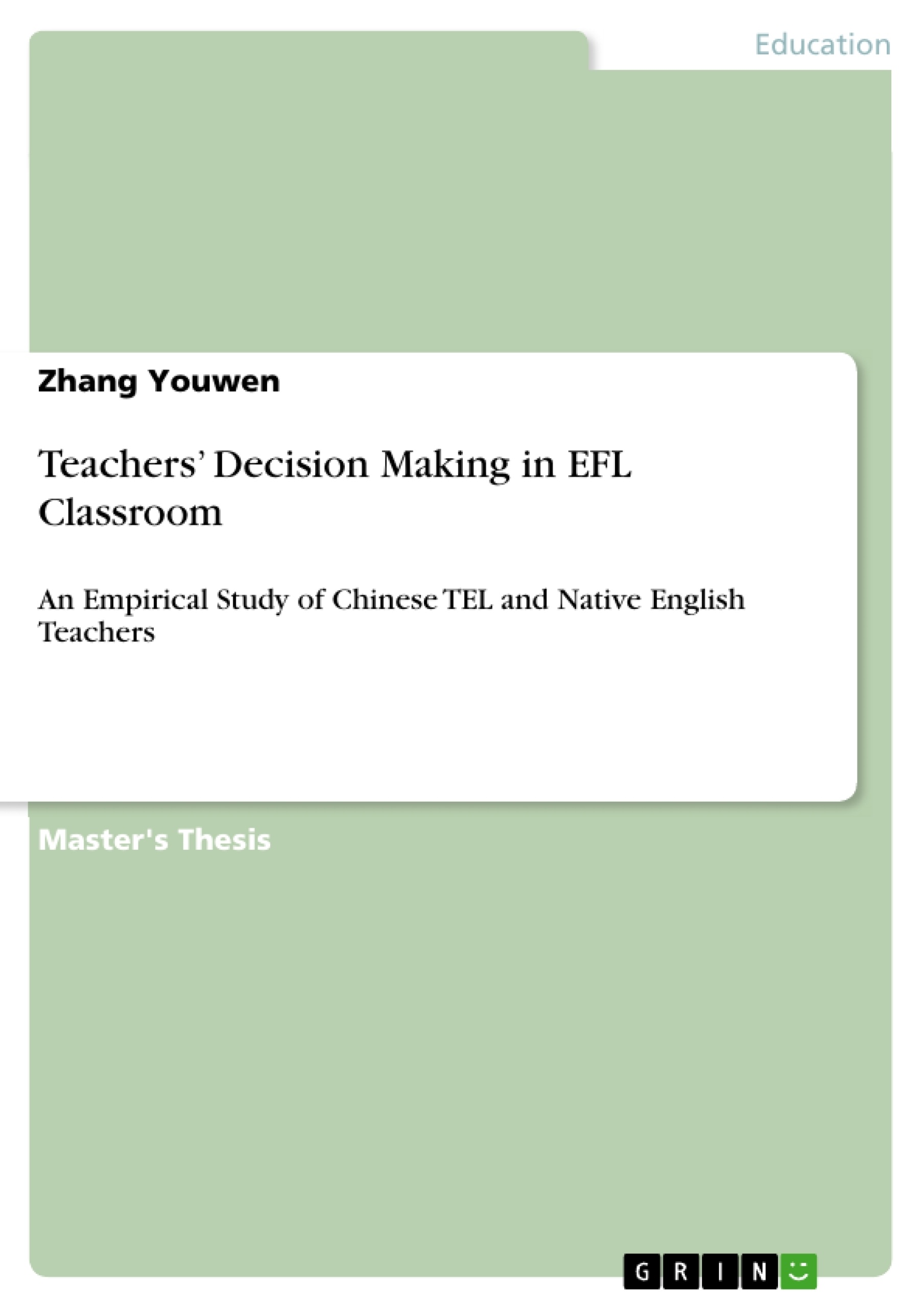This research attempts to make its contribution to the growing sociolinguistic literature on classroom foreign/second language learning and teaching.
It reports a comparative ethnographic inquiry into the similarities and differences of decision making and decision-making process employed by two categories of teachers when approaching planning and instruction in the language classrooms in Chinese EFL teaching context.
And the thought-provoking reasons for these similarities and differences have also been explored through the analysis of a range of broad research questions, i.e. first, how do two sets of teachers approach instructional decisions in the similar settings; second, can we have access to the similarities and differences between their instructional decisions; third, what factors might affect their pedagogical decisions; and fourth, are their instructional decisions consistent with their theoretical ideas.
Two categories of teachers consist of five Chinese TEL and five western teachers respectively, who work in two similar teaching institutions in China.The selected basic data gathered through a sequence of survey, observations, and particular information elicitation techniques consist of the running accounts of observation, lesson plans, and over fifty hours of audio-recording of class sessions and interviews.
Through analysis of selected lesson excerpts and teachers’ comments on these data we identify similarities and differences in the classroom interpretation of the tasks and participation structures that these teachers adopted in their instruction, and the underlying reasons behind them with reference to beliefs, context, prior experiences and culture.
The most general conclusion is that: whether they emphasize accuracy or fluency, and whether they prefer student-centered instruction or teacher-centered, they tend to capitalize on these theories eclectically, though they do differ in the extent to which they stress one focus or another. Therefore, much of a teacher’s decision on planning and instruction resides in the way he/she interprets the teaching setting and acts on the information from the ongoing classroom interactions.
In the last two chapters of this book, the subject of teacher's decision-making is explored from the perspective of soft power and critical discourse analysis, so that teachers' decision-making research can be considered more deeply in the aspect of cognitive, discourse and linguistic philosophy.
Inhaltsverzeichnis (Table of Contents)
- Chapter One Introduction
- Chapter Two Theoretical Background
- 2.1 Decision Making and Beliefs
- 2.2 Decision Making and Cognition
- 2.3 Decision Making and Experience
- 2.4 Decision Making and Context
- 2.5 Decision Making in Classroom Practice
- Chapter Three Design of the Study
- 3.1 Research Questions
- 3.2 Data Sample
- 3.2.1 Teachers
- 3.2.2 Institutions
- 3.3 Data Collection Procedures
- 3.3.1 Pre-observation Interviews
- 3.3.2 Observations
- 3.3.3 After-class Interviews
- 3.3.4 Scheduled Interviews
- Chapter Four Presentations of Data
- 4.1 Planning Decisions
- 4.2 Interactive Decisions
- Chapter Five Data Analysis and Discussion
- Chapter Six
The Influential Factors of Teachers' Decision Making
- 6.1 The Role of Teacher Beliefs in Pedagogic Decisions
- 6.2 The Role of Contextual Factors in Decision Making
- 6.2.1 Administrative Factors
- 6.2.2 Collegial Factors
- 6.2.3 Student Characteristics
- 6.3 The Role of Experience in Decision Making
- 6.4 The Role of Teacher Cognition in Decision Making
- 6.5 The Role of Cultural Factors in Decision Making
- Chapter Seven The Soft Power of Instructional Decision
- 7.1 Decision Making and Soft Power
- 7.2 Teachers' Decisions of Tasks and Participation Structure: Three Cases of Real-World Practice
- 7.3 The Underlying Factors Affecting Decision-making Soft Power
- 7.3.1 Teacher's Beliefs and Knowledge Shaping Decision-making Soft Power
- 7.3.2 Prior Experience Enhancing Decision- making Soft Power
- 7.3.3 Perceptions of the Context Facilitating Decision-making Soft Power
- 7.4 The Logicality of Teacher's Decision Making and Soft Power
- Chapter Eight Decision Making and Critical Discourse Analysis
- 8.1 The Critical Analysis of Teacher's Classroom Decision Making
- 8.2 Micro Discourse Analysis of Teachers' Instructional Decisions
- 8.3 Macro Discourse Analysis of Teachers' Decision Making
Zielsetzung und Themenschwerpunkte (Objectives and Key Themes)
This empirical study examines the decision-making processes of Chinese and native English teachers in EFL classrooms. The research aims to analyze the influential factors, including teacher beliefs, contextual factors, experience, and cognition, that shape teachers' instructional choices. The study also explores the concept of "soft power" in decision making, examining how teachers' decisions impact classroom dynamics and student learning.
- The role of teacher beliefs, experience, and cognition in EFL classroom decision making.
- The impact of contextual factors, including administrative, collegial, and student characteristics, on teacher decisions.
- The concept of "soft power" in teacher decision making and its influence on classroom dynamics and student learning.
- Comparative analysis of decision-making practices between Chinese and native English EFL teachers.
- Critical discourse analysis of teachers' classroom decision-making processes.
Zusammenfassung der Kapitel (Chapter Summaries)
Chapter One provides an introduction to the research topic, outlining the significance of teacher decision making in EFL classrooms and the gap in existing research. Chapter Two explores the theoretical framework of decision making, examining relevant concepts such as beliefs, cognition, experience, and context. Chapter Three details the research design, including the research questions, data sample, and data collection procedures. Chapter Four presents the collected data, focusing on both planning and interactive decisions made by teachers. Chapter Five analyzes the data and discusses the findings, highlighting the interplay between teacher beliefs, experience, and contextual factors in decision making. Chapter Six delves into the influential factors of teachers' decision making, examining the roles of teacher beliefs, contextual factors, experience, and cognition. Chapter Seven explores the concept of "soft power" in instructional decision making, providing examples of how teachers' decisions influence classroom dynamics and student engagement. Chapter Eight utilizes critical discourse analysis to examine teachers' decision-making processes, analyzing both micro and macro levels of discourse.
Schlüsselwörter (Keywords)
The core concepts of this study encompass teacher decision making, EFL classroom practice, teacher beliefs, contextual factors, experience, cognition, soft power, critical discourse analysis, and cross-cultural comparison.
- Citation du texte
- Zhang Youwen (Auteur), 2017, Teachers’ Decision Making in EFL Classroom, Munich, GRIN Verlag, https://www.grin.com/document/370563



